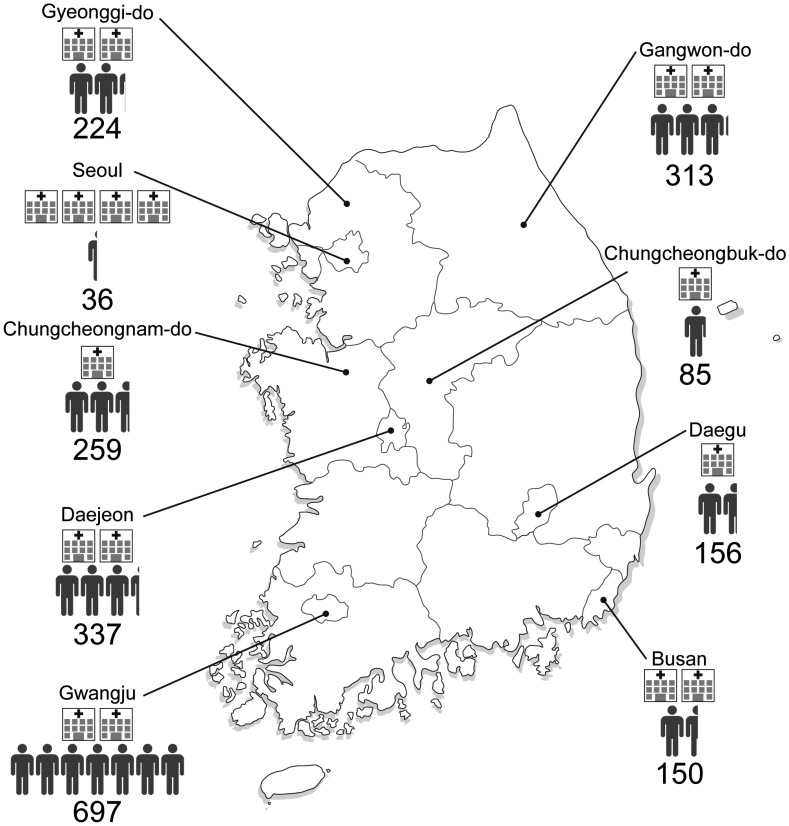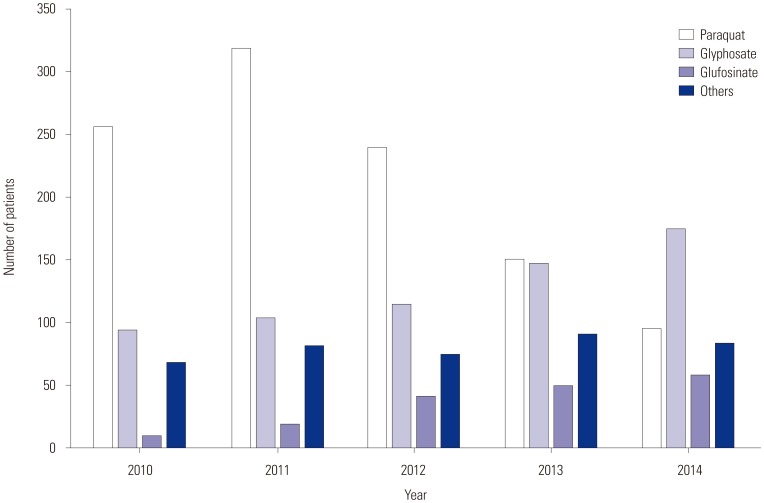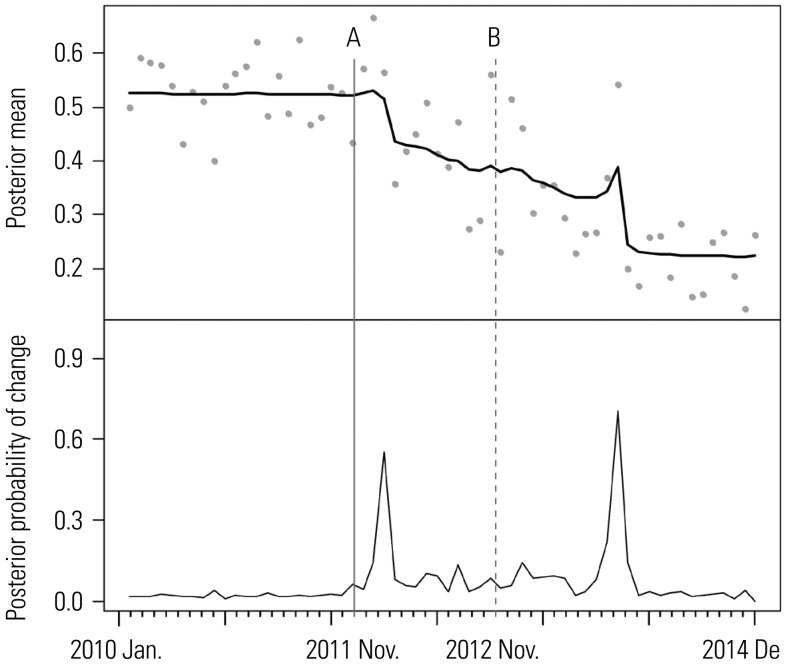Yonsei Med J.
2017 Jul;58(4):859-866. 10.3349/ymj.2017.58.4.859.
Effects of Paraquat Ban on Herbicide Poisoning-Related Mortality
- Affiliations
-
- 1Department of Emergency Medicine, Yonsei University College of Medicine, Gangnam Severance Hospital, Seoul, Korea. emstar@yuhs.ac
- 2Department of Emergency Medicine, College of Medicine, Chosun University, Gwangju, Korea.
- 3Department of Emergency Medicine, Chonnam National University Medical School, Gwangju, Korea.
- 4Department of Emergency Medicine, Yonsei University Wonju College of Medicine, Wonju, Korea.
- 5Department of Emergency Medicine, Samsung Changwon Hospital, Sungkyunkwan University School of Medicine, Changwon, Korea.
- 6Department of Emergency Medicine, Konyang University College of Medicine, Daejeon, Korea.
- 7Department of Emergency Medicine, Catholic University of Daegu School of Medicine, Daegu, Korea.
- 8Department of Emergency Medicine, Ajou University School of Medicine, Suwon, Korea.
- 9Department of Emergency Medicine, Inje University Ilsan Paik Hospital, Ilsan, Korea.
- 10Department of Emergency Medicine, Chungbuk National University Hospital, Cheongju, Korea.
- 11Department of Emergency Medicine, College of Medicine, Chungnam National University, Daejeon, Korea.
- 12Department of Emergency Medicine, Chuncheon Sacred Heart Hospital, College of Medicine, Hallym University, Chuncheon, Korea.
- 13Department of Emergency Medicine, Inje University Haeundae Paik Hospital, Busan, Korea.
- 14Department of Emergency Medicine, College of Medicine, Korea University Hospital, Seoul, Korea.
- 15Department of Emergency Medicine, Hanyang University College of Medicine, Seoul, Korea.
- 16Department of Emergency Medicine, Konkuk University School of Medicine, Seoul, Korea.
- 17Department of Research Affairs, Biostatistics Collaboration Unit, Yonsei University College of Medicine, Seoul, Korea.
- KMID: 2419095
- DOI: http://doi.org/10.3349/ymj.2017.58.4.859
Abstract
- PURPOSE
In Korea, registration of paraquat-containing herbicides was canceled in November 2011, and sales thereof were completely banned in November 2012. We evaluated the effect of the paraquat ban on the epidemiology and mortality of herbicide-induced poisoning.
MATERIALS AND METHODS
This retrospective study analyzed patients treated for herbicide poisoning at 17 emergency departments in South Korea between January 2010 and December 2014. The overall and paraquat mortality rates were compared pre- and post-ban. Factors associated with herbicide mortality were evaluated using logistic analysis. To determine if there were any changes in the mortality rates before and after the paraquat sales ban and the time point of any such significant changes in mortality, R software, version 3.0.3 (package, bcp) was used to perform a Bayesian change point analysis.
RESULTS
We enrolled 2257 patients treated for herbicide poisoning (paraquat=46.8%). The overall and paraquat poisoning mortality rates were 40.6% and 73.0%, respectively. The decreased paraquat poisoning mortality rate (before, 75% vs. after, 67%, p=0.014) might be associated with increased intentionality. The multivariable logistic analysis revealed the paraquat ban as an independent predictor that decreased herbicide poisoning mortality (p=0.035). There were two major change points in herbicide mortality rates, approximately 3 months after the initial paraquat ban and 1 year after complete sales ban.
CONCLUSION
This study suggests that the paraquat ban decreased intentional herbicide ingestion and contributed to lowering herbicide poisoning-associated mortality. The change point analysis suggests a certain timeframe was required for the manifestation of regulatory measures outcomes.
Keyword
MeSH Terms
Figure
Reference
-
1. Seok SJ, Gil HW, Jeong DS, Yang JO, Lee EY, Hong SY. Paraquat intoxication in subjects who attempt suicide: why they chose paraquat. Korean J Intern Med. 2009; 24:247–251. PMID: 19721862.
Article2. Gil HW, Hong JR, Jang SH, Hong SY. Diagnostic and therapeutic approach for acute paraquat intoxication. J Korean Med Sci. 2014; 29:1441–1449. PMID: 25408572.
Article3. Heylings JR, Farnworth MJ, Swain CM, Clapp MJ, Elliott BM. Identification of an alginate-based formulation of paraquat to reduce the exposure of the herbicide following oral ingestion. Toxicology. 2007; 241:1–10. PMID: 17825971.
Article4. Wilks MF, Tomenson JA, Fernando R, Ariyananda PL, Berry DJ, Buckley NA, et al. Formulation changes and time trends in outcome following paraquat ingestion in Sri Lanka. Clin Toxicol (Phila). 2011; 49:21–28. PMID: 21288148.
Article5. Vijayakumar L, Satheesh-Babu R. Does ‘no pesticide’ reduce suicides? Int J Soc Psychiatry. 2009; 55:401–406. PMID: 19617276.
Article6. Roberts DM, Karunarathna A, Buckley NA, Manuweera G, Sheriff MH, Eddleston M. Influence of pesticide regulation on acute poisoning deaths in Sri Lanka. Bull World Health Organ. 2003; 81:789–798. PMID: 14758405.7. Kervégant M, Merigot L, Glaizal M, Schmitt C, Tichadou L, de Haro L. Paraquat poisonings in France during the European ban: experience of the Poison Control Center in Marseille. J Med Toxicol. 2013; 9:144–147. PMID: 23435962.
Article8. Cha ES, Chang SS, Gunnell D, Eddleston M, Khang YH, Lee WJ. Impact of paraquat regulation on suicide in South Korea. Int J Epidemiol. 2016; 45:470–479. PMID: 26582846.
Article9. Lee JW, Hwang IW, Kim JW, Moon HJ, Kim KH, Park S, et al. Common pesticides used in suicide attempts following the 2012 Paraquat Ban in Korea. J Korean Med Sci. 2015; 30:1517–1521. PMID: 26425052.
Article10. Christensen J, Rudemo M. Multiple change-point analysis of disease incidence rates. Prev Vet Med. 1996; 26:53–76.
Article11. Erdman C, Emerson JW. bcp: an R package for performing a Bayesian analysis of change point problems. J Stat Softw. 2007; 23:1–13.
Article
- Full Text Links
- Actions
-
Cited
- CITED
-
- Close
- Share
- Similar articles
-
- Characteristics of Acute Herbicide Poisoning: Focused on Chlorophenoxy Herbicide
- Homicidal Paraquat Poisoning in Exhumed Case
- Clinical experience of hemoperfusion treatment in children with paraquat poisoning
- Clinical Observation of Paraquat Poisoning
- Prognostic Factors of Patients with Paraquat Poisoning




